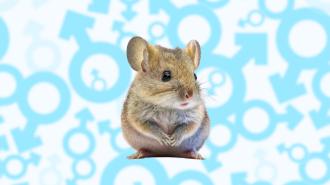For the first time, scientists have created healthy, fertile mouse pups from the DNA of two adult males — no female DNA required.
While the research is currently only a proof of concept and has yet to be peer-reviewed, the team behind the process thinks it could translate to people — meaning two men could potentially have biological children together one day.
Reproduction 2.0: For nearly all of humanity’s existence, reproduction has required sperm from one man and an egg from one woman — put the two together in a welcoming womb, and nine months later, you have a baby.
Science is disrupting this status quo.
“Purely in terms of technology, it will be possible [in humans] even in 10 years.”
Katsuhiko Hayashi
In 2016, researchers reported the birth of a baby with DNA from three people — the result of a technique to prevent him from inheriting a disorder from his mom. While all of the baby’s nuclear DNA came from one sperm and one egg, the child also inherited mitochondria, which have their own DNA, from a third donor.
The next major reproduction disruption could be babies born with DNA from two same-sex people.
My two dads: In 2004, researchers in Japan announced that, with a hefty dose of genetic manipulation, they’d managed to use the eggs of two female mice to create embryos. After implanting those embryos into a surrogate, she gave birth to a healthy pup.
In 2018, a team from China became the first to use DNA from two male mice to create embryos that developed into live pups — but those mice died just a couple of days after birth.
Now, researchers at Osaka University in Japan have announced that they’ve managed to create mouse pups from the DNA of two dads, and not only did these pups survive to adulthood, they were also able to become parents themselves (the ol’ fashioned way).
From 630 embryos implanted into surrogates, seven mouse pups were born.
How it works: The Osaka team announced its breakthrough at the Third International Summit on Human Genome Editing — the work has yet to be published, but they say they have submitted it to a peer-reviewed journal.
According to that presentation, the path to do the two-dad rodents started with the reprogramming of skin cells from male mice into induced pluripotent stem (iPS) cells. Through an elaborate process, the XY sex chromosomes in the cells were turned into XX chromosomes.
“The trick of this, the biggest trick, is the duplication of the X chromosome,” lead researcher Katsuhiko Hayashi told the Guardian. “We really tried to establish a system to duplicate the X chromosome.”
The cells were then cultivated inside an organoid designed to mimic the conditions of a mouse ovary. After that, sperm from male mice was used to fertilize the eggs, and from 630 embryos implanted into surrogates, seven mouse pups were born.
Looking ahead: The seven special mice lived to adulthood and were fertile, but Hayashi told Nature that his team plans to carefully study the rodents to look for any signs that they’re different from conventionally bred ones.
“That is not a question just for the scientific program, but also for [society].”
Katsuhiko Hayashi
The team is already attempting to use skin cells from human males to create eggs, but even if they can successfully reproduce their research in people — a huge if — the ethics and efficacy of creating people using such an experimental technique will need to be carefully considered.
After all, just this month, evidence has emerged that three-parent babies might be capable of inheriting their mothers’ mitochondrial disorders after all — illustrating how what we think is happening when we approach reproduction from an alternate angle isn’t always what’s actually happening.
“Purely in terms of technology, it will be possible [in humans] even in 10 years,” Hayashi told the Guardian of his team’s research. “I don’t know whether they’ll be available for reproduction. That is not a question just for the scientific program, but also for [society].”
We’d love to hear from you! If you have a comment about this article or if you have a tip for a future Freethink story, please email us at tips@freethink.com.
